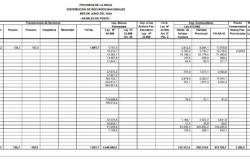Marcelo Orrego will meet today afternoon with Guillermo Francos, to ask that the Nation release funds again to reactivate public works in the province. The president has three main projects in the pipeline: Route 40 South, also known as the San Juan-Mendoza Highway; the Gran Tulum Aqueduct and the El Tambillo Aqueduct. The three projects had national financing, but Javier Milei’s management froze the funds at the beginning of the mandate. There will also be requests for funds to be transferred from other works that are in the portfolio. The initial objective is for them to send the games again, but in case of refusal, they will negotiate alternatives.
The Governor, who will go with the Minister of Infrastructure Fernando Perea, will meet at 4 p.m. with Milei’s new Chief of Staff of Ministers, Francos, who was previously in the Ministry of the Interior. San Juan’s request is to reactivate the works, which have been stopped since the beginning of the year due to lack of money. The dialogue takes place in the midst of negotiations between governors and the national administration, in the run-up to the May Pact, which depended on the approval of the Base Law. Along with Orrego, there will also be Maximiliano Pullaro, from Santa Fe, and Claudio Poggi, from San Luis.
From the Government, they assured that the priority is for the Nation to once again take charge of sending funds, since the projects are works of the central government and there was already a commitment. In case of refusal, they could negotiate that the funds first come out of the provincial coffers and then be returned. Something similar to this had already been agreed upon by the previous provincial administration with the government of Mauricio Macri to finish Route 40 North. If it is not successful, the province can request that part of the work be transferred and that it be completed with its own funds. In the latter case, there would be no refund of the money.
As for what they will seek to implement, the first three projects in priority are the two aqueducts and the highway, but they have “a long list” of options that are pending. Route 40 south has an advantage. In recent months there have been several expressions of support for completing the missing section. Mendoza officials, during the San Juan Mining Fair, said that they were going to promote the work together with San Juan. The industrial unions of Cuyo also put it among their requests in the meeting they held during May, in the same way the CAME and mining businessmen expressed themselves. The private sector has its sights set on this connection because they say it is central to economic development.
As for the aqueducts, they are two necessary works to guarantee the quality of drinking water for the local population. In the case of Greater Tulum, the province had already contributed its own funds to advance the payment of certificates, because the Nation’s transfers with the previous management were delayed. This work will provide drinking water to the entire Greater San Juan. The provision of this service throughout the Church depends on the El Tambillo aqueduct, since it connects underground water boreholes with the church town that gives it its name.
> Local works that have already resumed
In addition to the portfolio of national works that were paralyzed by the decision to freeze spending in this area, the crisis also affected local projects. The Government of San Juan announced in recent months the reactivation of part of these projects. As confirmed, the three areas where they decided to allocate funds as a priority were Health, Education and Housing. According to data from the Ministry of Infrastructure, currently 70% of local works that were stopped or slowed down are already underway again.
Orrego’s management first launched improvements in the schools, before the school year began. In February, they announced that they were going to allocate funds to repair more than 300 establishments, of which 100 were in “critical condition.” The same thing happened with Health infrastructure. In addition to investing mining funds in the Rodeo hospital, they restarted work on the Angaco Hospital and other health centers. To this they added the reactivation of the homes that had the greatest progress in the IPV and also the expansion of Calle 5.






